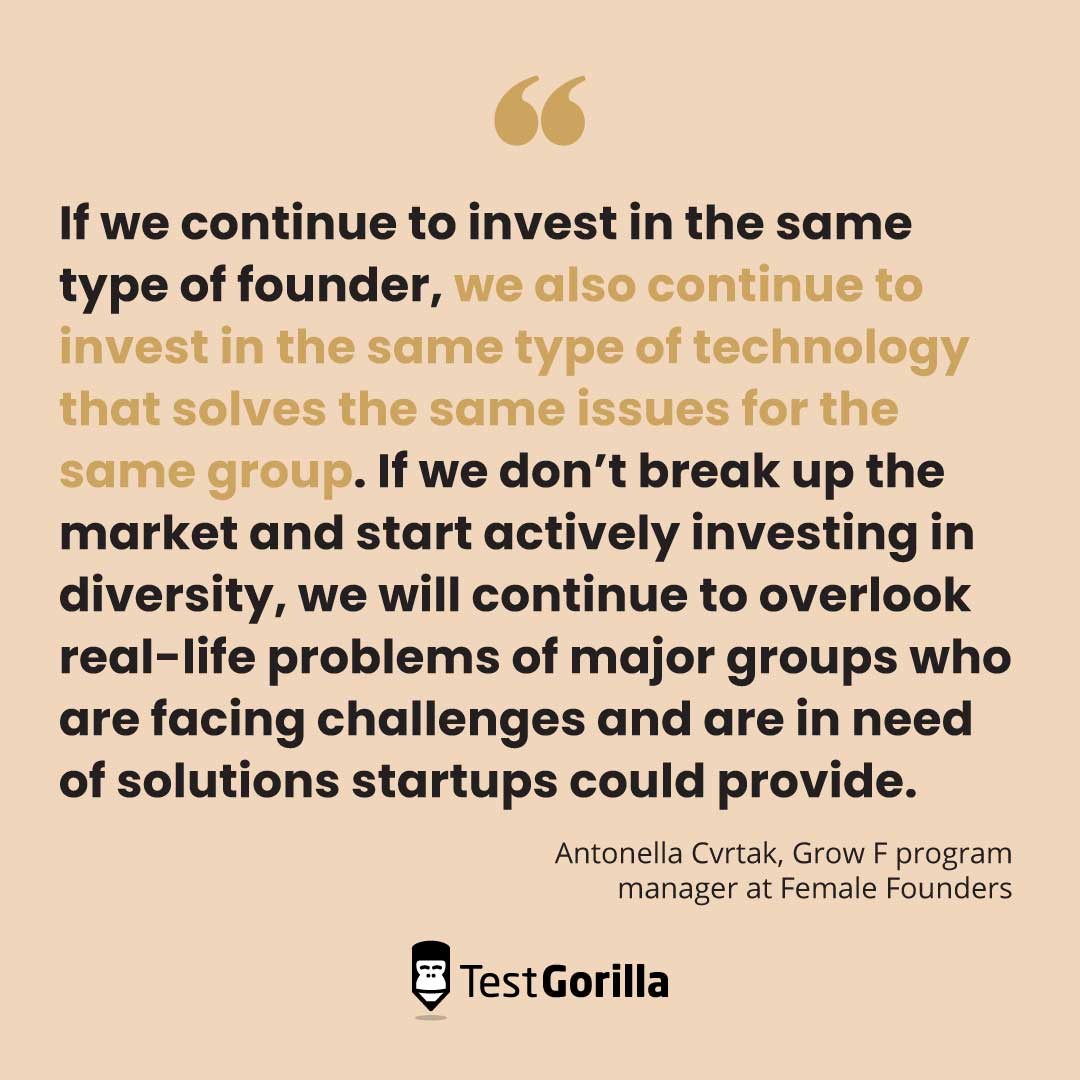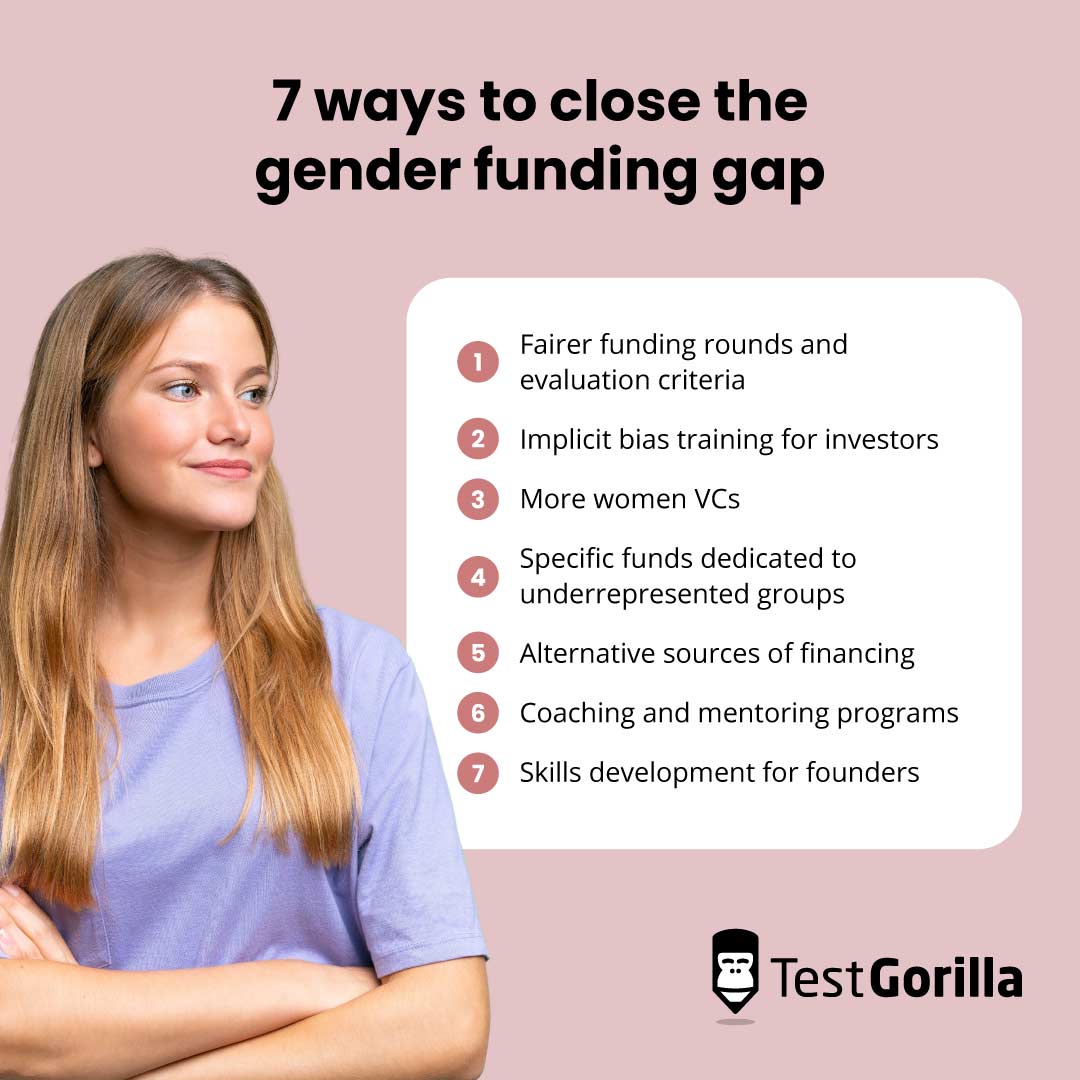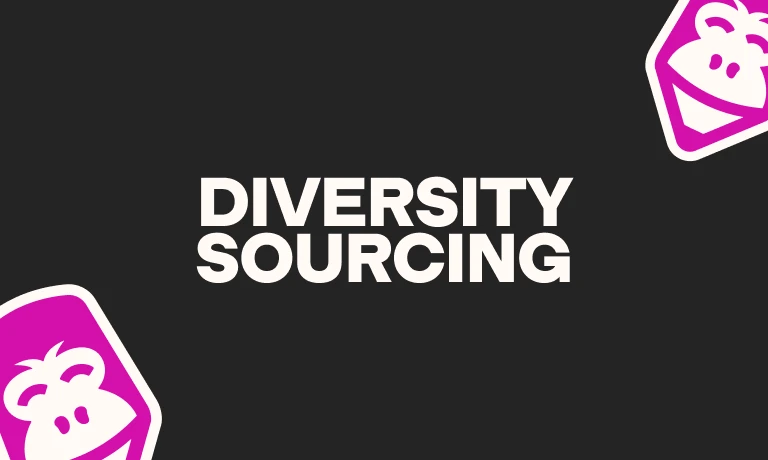For women and feminine-presenting people in the startup world, it can be easy to get discouraged about turning a brilliant idea into a long-term business due to the difficulties many encounter in securing funding.
This has nothing to do with their ability to innovate, run a company, or launch a successful business, and everything to do with the funding gap for women-led startups.
While the number of deals made by teams with a woman founder hovers around 5-6%, women-only startups receive only 1% of all venture capital (VC) funding in Europe. Compared to the 87% that men-only founding teams receive, it’s hard to deny the existence of a funding gap.[1]
Even when women are able to successfully pass a funding round, they’re likely to receive less than their men counterparts. Therefore, it’s not surprising that almost half of all European startups have no women on their boards.[2] Things aren’t much better in the US, where companies founded solely by women receive just around 2% of total venture-backed startup capital.[3]
The impacts of funding disparities reach far beyond upper-level representation in companies: Fewer women-run startups has a negative impact on innovation, society, and the economy as a whole.
In this post, we’ll explore the root causes and the impact of the funding gap for women-led startups. We’ll also provide seven recommendations to close the gender funding gap and make the startup world more equitable.
The impact of the funding gap for women-led startups
Startups are major drivers of economic recovery, sustainable growth, and even societal change, but they’re only successful if they fulfill an unmet need.[4]
“If you look at a founder’s story, they usually decide to tackle a problem because it’s something they can relate to,” says Antonella Cvrtak, who works as the “Grow F” program manager at Female Founders.
As long as the startup founder community remains homogeneous (tech especially is heavily dominated by young, white, college-educated men), the needs of women and marginalized groups continue to go unaddressed by new products.
Antonella says: “Femtech is a typical example of an underrepresented group in the startup world that makes up half of our global population. If you don’t invest in women’s health, that means you’re not creating new innovative solutions for 50% of the population.”
With lack of funds and a failure to raise new capital being the primary reason startups fail, women founders – especially Black, Indigenous, and people of color (BIPOC) – receiving lower amounts of funding has a serious impact on the types of products that make it to the market.[5]
Thirty-six percent of women founders cite securing access to capital as their biggest challenge, compared to less than a quarter of male founders.[1]
The disparities become even more significant with overlapping marginalized identities – Black women startup founders receive an even smaller portion of all VC funding.[6]
This becomes a vicious cycle of underrepresentation: The fewer women and feminine-presenting entrepreneurs that make it in the startup world, the fewer role models there are for others who are interested in becoming a founder. This means the sector remains homogeneous, with products that have an inherent bias towards men, since it’s men who largely create them. This is especially true in the tech world and the algorithms that increasingly govern our lives.
“If we continue to invest in the same type of founder, we also continue to invest in the same type of technology that solves the same issues for the same group. If we don’t break up the market and start actively investing in diversity, we will continue to overlook real-life problems of major groups who are facing challenges and are in need of solutions startups could provide.” - Antonella Cvrtak, Grow F program manager at Female Founders
3 reasons for the gender funding gap
Poor performance isn’t the reason why women receive significantly lower funding than men: Startups founded or cofounded by women are better investments, generating 78 cents for every dollar of funding. By contrast, men-founded startups generate just 31 cents on the dollar.[7]
Antonella emphasizes that the issues that cause the gender funding gap are multi-faceted. Ultimately, it boils down to three main factors: Stereotypes, biased evaluation criteria, and the homogeneity of the current startup and VC ecosystem.
Let’s explore those in more detail.
1. Societal bias and stereotypes
Men hold the majority of decision-making roles at 95.5% of VC firms in the US.[8] Consequently, women founders often face societal bias come time to secure funding.
According to Antonella, stereotypes (and failure to address them) negatively impact women in the startup ecosystem.
“If you look at how investors make their decisions, you’ll see there’s bias in decision-making positions,” she says. For example, there’s an unfounded but persistent belief that investing in men founders is less risky. Biases like this have a negative impact on women’s ability to secure funding.
Additionally, stereotypes like women being less competitive than men or less equipped for leadership can creep into the VC decision-making process, thwarting a woman founder's ability to gain the trust of investors and secure funding.
2. Biased evaluation criteria
It’s not just the inherent biases of investors that plague the VC world: It’s the process itself.
Biased evaluation criteria negatively impact the fundraising process for women-led startups.
For example, VC teams place an emphasis on the experience of a startup team when making investment decisions. Women – especially those from underrepresented groups – may lack the experience investors value, perhaps because of career gaps due to the glass ceiling or caregiver commitments.
Even more significant, investors tend to ask women different questions than men when seeking out funding. “There’s this phenomenon that men are more likely to get asked questions about their vision and inspiration, the future, and bigger picture goals,” Antonella says. “Women are more likely to get asked more challenging questions, like ones related to a worst-case scenario or what skills and competencies they have.”
3. It’s a boys’ club
Networking is a major component of fundraising in the startup world. If you’re a new woman founder on the scene, you may not have the same connections or advocates as your men counterparts. They likely already have a wide network of contacts and colleagues to lobby for them.
“Investors like to receive recommendations from their network, and they like to hear from founders from multiple people. They really do use these recommendations to make investment decisions,” Antonella says.
Additionally, people tend to trust people who are similar to them, primarily when that person is the same gender.[9] This means a White man investor is naturally inclined to trust a White man more than a woman, especially a Black one.
The best insights on HR and recruitment, delivered to your inbox.
Biweekly updates. No spam. Unsubscribe any time.
7 ways to close the gender funding gap
Though much needs to be done to fill the gender funding gap, it’s finally becoming an issue investors care about.
“More investors are noticing that diversity is a huge topic and also a game changer when it comes to being more resilient in times of crisis,” Antonella says. “So a lot of limited partners are putting more pressure on the funds they’re investing in to promote diversity.”
While that’s a good start, there are still a number of things VC firms, women founders, and businesses can do to help women and feminine-presenting people secure more funding for their startups.
Here are seven ways to help close the gender funding gap for women founders.
1. Fairer funding rounds and evaluation criteria
As mentioned, fundraising is far from an objective process. Often, women get asked more challenging, pointed questions than men.
To make the evaluation and interview process fairer, investors should be intentional about asking the same questions to all founders, regardless of their gender.
This could have a huge impact on making the fundraising process more equitable: Entrepreneurs tend to raise significantly lower funds when asked prevention-focused questions than promotion-focused questions. Prevention-focused questions might include things like “What’s your plan to avoid failure?” and are more often asked of women. By contrast, men are more frequently asked promotion-focused questions such as “How do you plan to market the product?”
These small changes, in combination with placing less emphasis on your connections and network, could give women a much better shot at raising capital that’s on par with their men counterparts.
2. Implicit bias training for investors
It’s not just about asking fair questions. Investors should also undergo implicit bias training to understand how underlying beliefs and stereotypes may influence their decision-making process.
Because it’s so deeply embedded in our brains, unconscious bias can be hard to overcome. To make implicit bias training work, there are a few things that need to happen:
Leverage knowledge to change behavior. If they aren’t aware of their biases, VCs won’t be capable of eliminating them. That’s why education is a crucial first step in the process.
Avoid quick fixes. Biases aren’t broken down in a day, so training needs to be a consistent effort that takes place over time.
Diversify VC firms. To remove bias from the startup funding process, we need more women, who can educate their male peers and empathize with women founders, in decision-making roles.
Pro tip: Check out Diversity VC, an organization that’s committed to setting a global standard for D&I best practices in the VC industry.
3. More women VCs
As commented, more women investors are essential to help women founders secure more funding. However, women make up just 16.1% of decision-making roles in US VC firms.[8]
Women VC partners invest in two times more women-led startups at the early stages than men partners.[10] So more of them means more opportunities for women-led businesses to secure funding.
Just like in the startup world, having networks that support and help train women is key to giving them more access to positions in VC firms. Women in VC and the SUPERNOVAS Women Investors Community (WIN) are some examples of initiatives to increase women’s participation and representation in investing.
4. Specific funds dedicated to underrepresented groups
Achieving parity in the VC world is the ideal, but it could take decades. For a more immediate solution, special funds dedicated to women and underrepresented groups can make a big difference.
“There are so many great programs out there supporting women-led companies, but at the end of the day, what those startups need is funding,” Antonella says. “A crucial trend I’m seeing is funds dedicated to underrepresented groups. I think this is the kind of solution that has the most effect.”
There are a number of women-focused funds out there that women founders and entrepreneurs from underrepresented groups can look to for capital, including:
5. Alternative sources of financing
While it’s certainly one of the most well-known approaches to funding a startup, venture capital isn’t a founder’s only option. Normal bank loans, crowdfunding, bootstrapping, and organic growth can all help startups get on their feet before aiming for a larger round of funding.
There are two other sources of financing that can be especially interesting to women founders: Angel investors and grants. The number of women angel investors is growing, and about a third of US angel investors are women, making up a higher percentage than their representation in VC. [11][12]
Grants are another excellent source of funding for women and diverse startup founders.
“You can see more grants dedicated to underrepresented groups, gender-diverse companies, and female founders popping up,” Antonella says. “Female founders should look into these because they provide you with a good amount of money without requiring you to give up equity, making them very attractive for early-stage startups.”
6. Coaching and mentoring programs
Your network can make or break your ability to meet the right people to help you raise capital. That’s why coaching and mentoring are so important for women entrepreneurs.
Having women role models who are successful in the startup sector can help both educate and inspire founders who may feel unsure about the best way to approach fundraising or discouraged by past rejection.
For example, the Women’s Founders Network provides mentoring opportunities through its annual Fast Pitch competition. Or look at Female Founders’ Grow F, a five-week program that provides participants with individual support, workshops from industry experts, and a wide network that can support them throughout their fundraising process.
7. Skills development for founders
Finally, founders need to have the right skills to secure funding and ensure their business succeeds:
Negotiation, leadership, networking, pitching, and fundraising are essential skills women and feminine-presenting entrepreneurs need to have if they want to make it in the startup world.
Programs like Grow F, All Raise masterclasses, and Female Founder Space’s online courses can help women and feminine-presenting people gain the skills they need to turn their ideas into sustainable businesses. Then, entrepreneurs can use talent assessments to check their skills are where they need to be.
Companies and HR departments can also support employees by using talent assessments to pinpoint knowledge gaps and offer customized training and courses to help them develop their skills.
While it may seem counterintuitive to train your best people to go it alone, talent hoarding can actually hurt your business. Reduced productivity, lower employee morale, and damaged relationships are just a few examples of what can happen when you don’t help your people progress in their careers – even if that progression means leaving you.
This is why it’s beneficial to help your employees develop their skills no matter what the outcome, whether it be moving up in your organization or starting their own business. Plus, startup founders tend to retain strong ties to companies they formerly worked for, so helping your people advance in their careers, wherever that may be, is to your benefit.
More funding for women founders: Better for business, better for the world
More funding for women and feminine-presenting founders is better for business: Gender-diverse teams are 25% more likely to financially outperform their counterparts, which is a compelling incentive for investors.
More capital for startups led by women and feminine-presenting people means better innovation, more unique solutions to answer specific needs, and more role models for others who see a future in entrepreneurship. This leads to greater diversity in tech and more equitable recruitment for startups.
That’s why it’s so important to make sure women and feminine-presenting people have the skills they need to thrive in the startup world. We must also work to break down the barriers that currently hold them back, such as stereotypes, inherent bias in the VC world, and unfair assessment criteria.
These obstacles can be overcome through implicit bias training for investors; getting more women into VC firms; providing coaching and mentoring for women entrepreneurs; and exploring alternative sources of funding. Also, by using talent assessments to develop the skills needed to successfully pitch, secure funding, and achieve startup success.
However, it’s important for these entrepreneurs to stay positive and get out there despite the perceived challenges. “There's so much momentum out there when it comes to gender diversity,” Antonella says. “There's more and more money being allocated to female-led startups. Even though it might not always seem that way, I do think it's a good time for women to go out there, talk to investors, and fundraise.”
Want to build a more equitable workplace and world? Skills-based hiring lets you hire the right people for your open roles, whoever they are. |
Sources
“State of DEI.” (2022). State of European Tech 2022. Retrieved July 21, 2023. https://stateofeuropeantech.com/reading-tracks/state-of-dei
“2023 Research and Trends: Turning Intention into Action.” (2023). ESG_VC. Retrieved July 21, 2023. https://www.esgvc.co.uk/wp-content/uploads/2023/06/ESG_VC_BVCA_Research_2023.pdf
“US VC female founders dashboard.” (2023). PitchBook. Retrieved July 21, 2023. https://pitchbook.com/news/articles/the-vc-female-founders-dashboard
“How startups drive economic recovery while growing responsibly.” (2022). World Economic Forum. Retrieved July 21, 2023. https://www.weforum.org/agenda/2022/05/how-startups-help-drive-economic-recovery-and-growth/
“The Top 12 Reasons Startups Fail.” (2021). CB Insights. Retrieved July 21, 2023. https://www.cbinsights.com/research/report/startup-failure-reasons-top/
“Black Women Still Receive Just A Tiny Fraction Of VC Funding Despite 5-Year High.” (2021). Crunchbase News. Retrieved July 21, 2023. https://news.crunchbase.com/diversity/something-ventured-black-women-founders/
“Why Women-Owned Startups Are a Better Bet.” (2018). Boston Consulting Group. Retrieved July 21, 2023. https://www.bcg.com/publications/2018/why-women-owned-startups-are-better-bet
“All In: Female Founders in the US VC Ecosystem.” (2022). PitchBook. Retrieved July 21, 2023. https://pitchbook.com/news/reports/2022-all-in-female-founders-in-the-us-vc-ecosystem
“You trust a face like yours.” (2022). Humanities and Social Sciences Communications. Retrieved July 21, 2023. https://www.nature.com/articles/s41599-022-01248-8
“Women VCs Invest in Up to 2x More Female Founders.” (2020). Kauffman Fellows. Retrieved July 21, 2023. https://www.kauffmanfellows.org/journal/women-vcs-invest-in-up-to-2x-more-female-founders#:~:text=At%20the%20Kauffman%20Fellows%20Research,overall%20economy%20and%20job%20growth
“Gender bias or how investors are missing the best investment opportunities.” (2022). EBAN. Retrieved July 21, 2023. https://www.eban.org/gender-bias-or-how-investors-are-missing-the-best-investment-opportunities/
“WeAngels (Women Entrepreneur Angel Investors).” (2023). Kinect Capital. Retrieved July 21, 2023. https://kinectcapital.org/weangels/
Related posts
You've scrolled this far
Why not try TestGorilla for free, and see what happens when you put skills first.





















